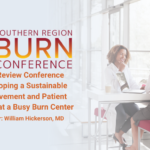Abstract | December 20, 2021
Simplifying the Treatment Pathway Algorithm and Number of Operations: Use of ASCS for Thermal Burn Injuries
Learning Objectives
- Learn how NBR data can be utilized as a benchmark to compare effectiveness of new technologies to conventional techniques for burn care.
- Understand the impact of autograft sparing technologies when incorporated into the burn treatment algorithm, specifically the reduction of operative procedures compared to traditional autografting for mixed depth/fullthickness injuries.
Introduction:
Each year in the US alone, nearly 500,000 patients seek medical care for burns, with approximately 40,000 patients requiring hospitalization. A primary goal of burn care is rapid and lasting closure, as this has considerable influence on metabolic demand as well as functional outcomes and long-term quality and appearance of healed tissue. Two patient populations particularly vulnerable to morbidity and mortality include pediatrics and patients with large TBSA injuries. In both populations, multiple conventional autografting procedures are required to obtain definitive closure, largely due to limited donor skin availability due to injury. In pediatrics there are further donor constraints based on small total body surface area and the requirement to avoid challenging anatomical regions. While the donor sites heal for the purpose of being reharvested, open burn wounds are at risk for infection and future scarring. In addition to potential complications at the wound site, each operation has associated risks and costs, pain and distress, and impacts overall time to closure. Autologous skin cell suspension (ASCS) provides an autograft-sparing complement to surgical management, significantly reducing the amount of donor skin harvesting required for definitive closure. The primary objective of this study was to perform a benchmarking analysis using real-world data to understand the impact of ASCS on the number of autograft treatments to achieve definitive closure for full-thickness acute thermal burns in adult patients with severe burn injuries and pediatric patients. Additionally, adverse event rates for ASCS treatment were compared to conventional autografting procedures.
Methods:
A retrospective analysis of real-world data was conducted, evaluating clinical outcomes for ASCS-treated patients compared to those receiving conventional autografting for the treatment of full-thickness acute thermal burn wounds. The adult analyses included patients ≥ 18 years of age with >50% TBSA injury. The pediatric population consisted of patients under 18 years of age, inclusive of any size TBSA. The ASCS Cohort data were derived from prospective, uncontrolled observational studies (Compassionate Use IDE 15945, Continued Access IDE 13053). For the Control Cohort, data were derived from the National Burn Repository version 8.0 (2002 to 2011) (NBR). Within the analyses, propensity score stratification was used to reduce bias associated with potential differences in key covariates between the ASCS and Control Cohorts. To evaluate safety outcomes, the data for conventional autografting procedures from the pivotal clinical trial (IDE 13053) (Historical Control) was used for comparative purposes.
Results:
No statistically significant differences were found in analysis populations for age, %TBSA, gender, or Baux scores between the ASCS-treated patients ≥ 18 years of age with >50% TBSA injury (n=49) and control NBR (n=277) patient subgroups (p>0.05). Mean %TBSA for the ASCS-treated patients was 65.5±11.2% and Control Cohort 61.9±10.1%. Baux scores were 110.1±19.8 for the ASCS-treated patients and 107.6±17.4 for the Control Cohort. For the pediatric population, the ASCS Cohort (n=39) and Control Cohort (n=245) were well matched after adjusting for propensity score according to age (7.1 and 8.7 years, respectively), female gender (53.8% and 26.9%, respectively). Mean TBSA (40.1% vs 28.1%) and Baux Scores (50.3 and 39.3) were numerically greater in the ASCS Cohort compared with the NBR data and even after propensity score adjustment, mean %TBSA remained statistically higher for the ASCS cohort (p=0.0439).
For both the adult >50% TBSA and pediatric patient populations the median number of autograft treatments required to achieve definitive closure was found to be statistically reduced with ASCS-treatment compared to the relevant Control Cohorts (p<0.0001, based on propensity adjusted Poisson regression model). For the adult patients, the ASCS Cohort median was 2 (range 1-6) and the Control Cohort median was 5 (range 1-32). For the pediatric patients, the ASCS Cohort median was 1 (range 1- 5) and the Control Cohort median was 2 (range 1-20). In addition to autograft treatments, wound healing was evaluated for both patient populations. By week 8, 271/299 (90.6%) ASCS-treated wounds achieved ≥95% reepithelialization. For the pediatric population evaluated, 91.8% of wounds were healed by Week 8 with no events of spontaneous wound breakdown of the skin longterm. Although data from the NBR were not available for direct comparison, the wound healing achieved with ASCS is within normal limits for the patient populations evaluated based on previously published literature for conventionally grafted control wounds.
Comparison of the ASCS Cohort to the Control Cohort (historical comparator) was used to evaluate incidences of specific burn treatment-related adverse events (i.e., infection, skin graft failure and graft loss and/or impaired healing). For the adult population with >50% TBSA, the incidence of graft loss/impaired healing was comparable to conventional skin grafting. Incidences of skin graft infection and skin graft failure were found to be higher in the ASCS Cohort, due to complications associated with having more extensive burns. Further, multiple wounds were treated within the ASCS Cohort, therefore there were more opportunities (approximately 10x) for treatment area complications compared to the single wound treated in the control group. In the pediatric population, the number of patients experiencing at least one treatment-related adverse event was similar between the ASCS Cohort and the Control Cohort comparative data (17.9% vs 20.0%, respectively.)
Conclusions:
Data from this real-world analysis demonstrates the positive impact of ASCS treatment on the number of surgical procedures needed to achieve closure. Reduced numbers of operations and the associated earlier definitive closure benefits patients and offers burn centers reduced complexity and cost in the patient care pathway

